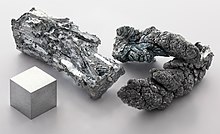
Zinc
Chemical element, symbol Zn and atomic number 30 / From Wikipedia, the free encyclopedia
Dear Wikiwand AI, let's keep it short by simply answering these key questions:
Can you list the top facts and stats about Zinc?
Summarize this article for a 10 year old
Zinc is a chemical element; it has symbol Zn and atomic number 30. It is a slightly brittle metal at room temperature and has a shiny-greyish appearance when oxidation is removed. It is the first element in group 12 (IIB) of the periodic table. In some respects, it is chemically similar to magnesium: both elements exhibit only one normal oxidation state (+2), and the Zn2+ and Mg2+ ions are of similar size.[note 1] Zinc is the 24th most abundant element in Earth's crust and has five stable isotopes. The most common zinc ore is sphalerite (zinc blende), a zinc sulfide mineral. The largest workable lodes are in Australia, Asia, and the United States. Zinc is refined by froth flotation of the ore, roasting, and final extraction using electricity (electrowinning).
Zinc is an essential trace element for humans,[6][7][8] animals,[9] plants[10] and for microorganisms[11] and is necessary for prenatal and postnatal development.[12] It is the second most abundant trace metal in humans after iron, and the only metal which appears in all enzyme classes.[10][8] It is also an essential nutrient element for coral growth as it is an important cofactor for many enzymes.[13]
Zinc deficiency affects about two billion people in the developing world and is associated with many diseases.[14] In children, deficiency causes growth retardation, delayed sexual maturation, infection susceptibility, and diarrhea.[12] Enzymes with a zinc atom in the reactive center are widespread in biochemistry, such as alcohol dehydrogenase in humans.[15] Consumption of excess zinc may cause ataxia, lethargy, and copper deficiency. In marine biomes, notably within polar regions, a deficit of zinc can compromise the vitality of primary algal communities, potentially destabilizing the intricate marine trophic structures and consequently impacting biodiversity.[16]
Brass, an alloy of copper and zinc in various proportions, was used as early as the third millennium BC in the Aegean area and the region which currently includes Iraq, the United Arab Emirates, Kalmykia, Turkmenistan and Georgia. In the second millennium BC it was used in the regions currently including West India, Uzbekistan, Iran, Syria, Iraq, and Israel.[17][18][19] Zinc metal was not produced on a large scale until the 12th century in India, though it was known to the ancient Romans and Greeks.[20] The mines of Rajasthan have given definite evidence of zinc production going back to the 6th century BC.[21] To date, the oldest evidence of pure zinc comes from Zawar, in Rajasthan, as early as the 9th century AD when a distillation process was employed to make pure zinc.[22] Alchemists burned zinc in air to form what they called "philosopher's wool" or "white snow".
The element was probably named by the alchemist Paracelsus after the German word Zinke (prong, tooth). German chemist Andreas Sigismund Marggraf is credited with discovering pure metallic zinc in 1746. Work by Luigi Galvani and Alessandro Volta uncovered the electrochemical properties of zinc by 1800. Corrosion-resistant zinc plating of iron (hot-dip galvanizing) is the major application for zinc. Other applications are in electrical batteries, small non-structural castings, and alloys such as brass. A variety of zinc compounds are commonly used, such as zinc carbonate and zinc gluconate (as dietary supplements), zinc chloride (in deodorants), zinc pyrithione (anti-dandruff shampoos), zinc sulfide (in luminescent paints), and dimethylzinc or diethylzinc in the organic laboratory.

